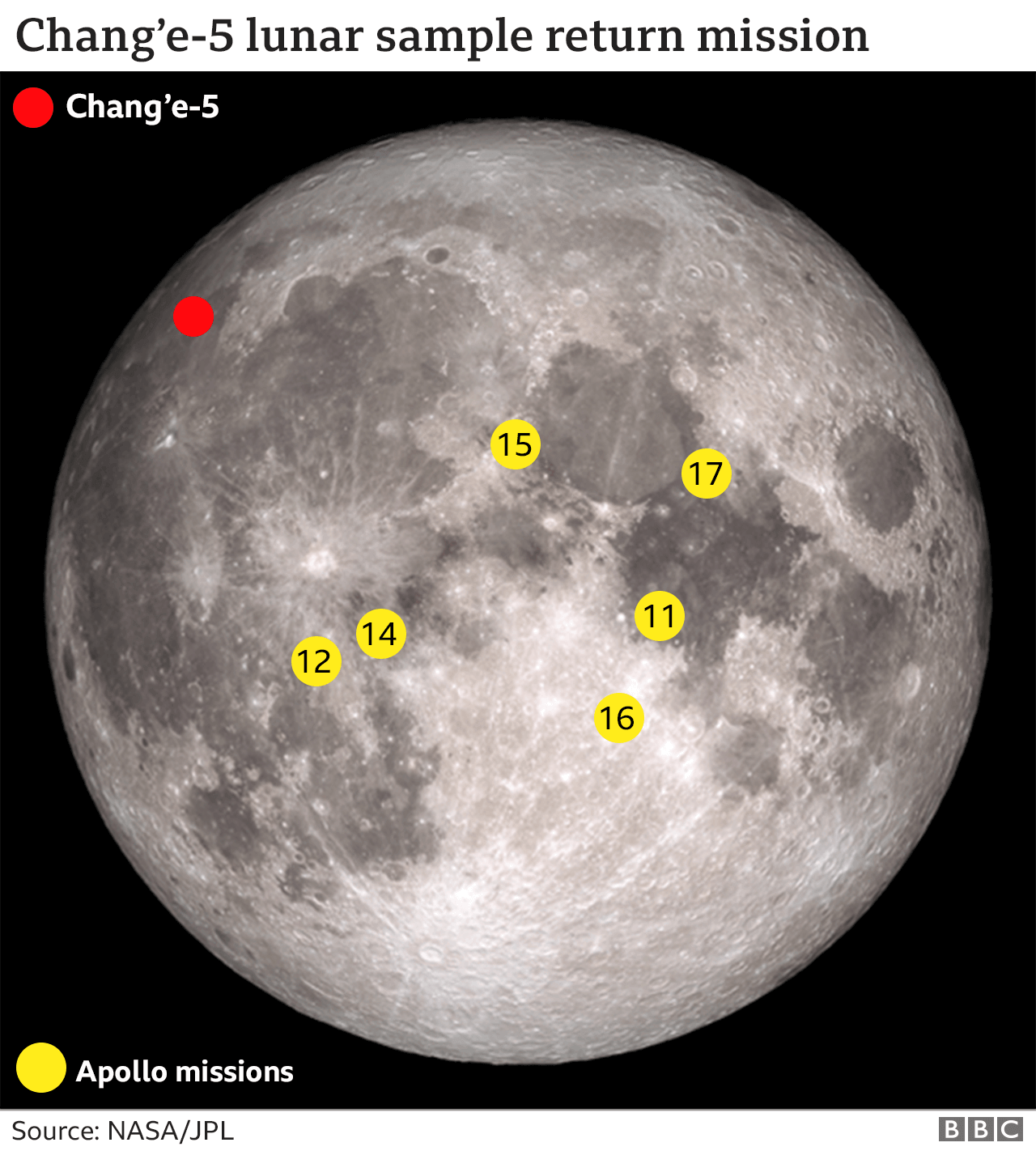9.10.2021

The rock samples brought back from the Moon in December by China's Chang'e-5 mission were really young.
It's all relative, of course, but the analysis shows the basalt material - the solidified remnants of a lava flow - to be just two billion years old.
Compare this with the samples returned by the Apollo astronaut missions. They were all over three billion years of age.
The findings are reported in the journal Science.
China's robotic Chang'e-5 mission was sent to a site on the lunar nearside called Oceanus Procellarum.
It was carefully chosen to add to the sum of knowledge gained from previous sample returns - the last of which was conducted by a Soviet probe in 1976.

Xiaochao Che and colleagues at the Sensitive High Resolution Ion MicroProbe (SHRIMP) Center in Beijing led the Chang'e-5 dating analysis, but worked with a broad international consortium.
The age data they've produced is fascinating because it proves volcanism continued on the Moon long after one might have expected such a small body to have cooled down and given up the activity.
Theorists will now be thinking through new ideas for what kind of heat source might have sustained the late-stage behaviour.
It doesn't appear to have been driven by concentrated radioactive decay because the Chang'e-5 samples don't contain a lot of the kind of chemical elements associated with this effect.
"One of the other options we discuss in the paper is maybe the Moon was able to stay active longer because of its orbital interactions with Earth," speculated Dr Katherine Joy, a co-author from the University of Manchester, UK.
"Maybe the Moon wobbled back and forth on its orbit, resulting in what we call tidal heating. So, a bit like the Moon generates ocean tides on Earth, maybe the gravitational effect of the Earth could stretch and flex the Moon to generate frictional melting," she told BBC News.
 IMAGE SOURCE, CNSA
IMAGE SOURCE, CNSAOne really important outcome from the study is the way it helps calibrate the crater-counting technique that is used for dating planetary surfaces.
Scientists assume that the more craters they see on a surface, the older that terrain must be; and also, obviously, in the reverse: the presence of very few craters is suggestive of a surface that has only recently been laid or remodelled.
But this technique has to be anchored in some absolute dates that are derived from measured samples, and for the Moon the chronology was not well constrained between one and three billion years ago.
The Chang'e-5 material now provides a precise waypoint in the middle of this time period.


Prof Brad Jolliff, from Washington University in St Louis, US, is another co-author in the consortium. He's now hoping China will send its next sample return mission to a region on the Moon's farside called South Pole Aitken Basin.
This vast depression, some 2,500km wide and up to 8km deep, was created by a spectacular impactor very early in lunar history.
"If Chang'e-6 goes to South Pole Aitken it will give us the age of the oldest big impact basin on the Moon, and that provides a very different part of the calibration, in the range of four to four-and-a-half billion years ago. We don't know what the flux of big impactors was back then, and a sample from the South Pole Aiken Basin region has the potential to answer the question."
Chang'e-5 marked the start of an astonishing few months for China's national space programme.
Within six months of the lunar probe returning home with its rock samples on 16 December, another spacecraft had successfully entered orbit around Mars to place a rover on its surface; and Chinese astronauts had begun the occupation of a new space station at Earth.
Quelle: BBC
+++
Lunar samples brought back by Chang'e-5 identified as youngest rocks ever found on the Moon
The basaltic volcanic rocks, collected as part of China's Chang'e-5 probe from the Moon, were about 2 billion years old, marking the youngest volcanic rocks identified on the Moon so far, according to an international research published in the journal Science on Friday.
Professor Alexander Nemchin from Space Science and Technology Center of Australia's Curtin University, lead author of the research, said researchers determined the age of the lunar rock samples during remote sessions with the Beijing laboratory using large mass spectrometers that have helped revolutionize geology, similar to Curtin's Sensitive High Resolution Ion Micro Probe Facility (SHRIMP).
The rock samples were collected during the Chang'e-5 lunar mission in December 2020, which marked the first time any nation had collected rocks from the Moon since 1976.
Nemchin said after analyzing the chemistry of the rocks, they found the samples were 1 billion years younger than those rocks previously collected on the Moon.
Co-author Professor Gretchen Benedix, also from Curtin's Space Science and Technology Center, said the new results would provide researchers with more calibration points for cratering chronology, enabling them to derive more accurate and higher resolution ages across many planetary surfaces.
"These results confirm what experts had long predicted based on remotely obtained images of the Moon and raise further questions as to why these young basalts exist," Benedix said.
The task will now turn to finding a mechanism that will explain how this relatively recent heating of the Moon may have supported the formation of basaltic magmas with temperatures exceeding 1,000 degrees Celsius, and ultimately help researchers improve age dating of the entire Solar System. Enditem
Quelle: Xinhua
